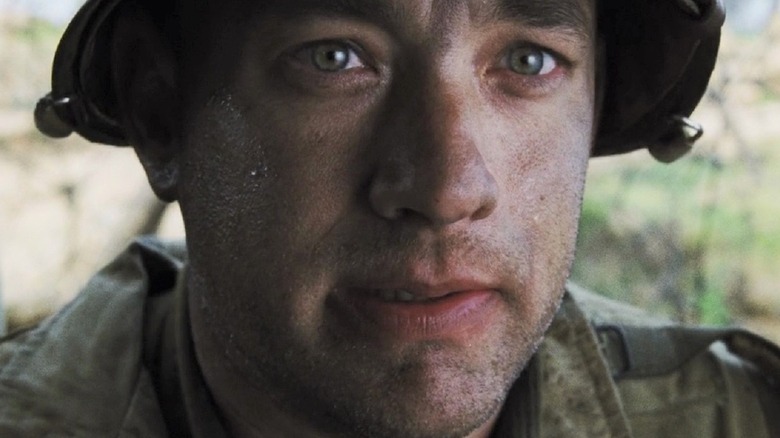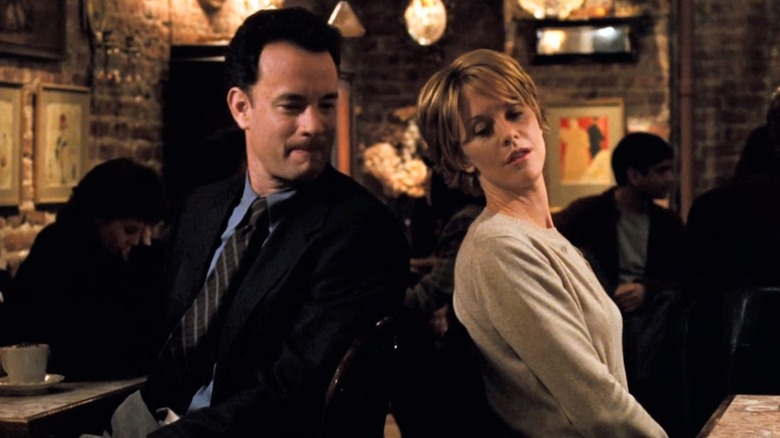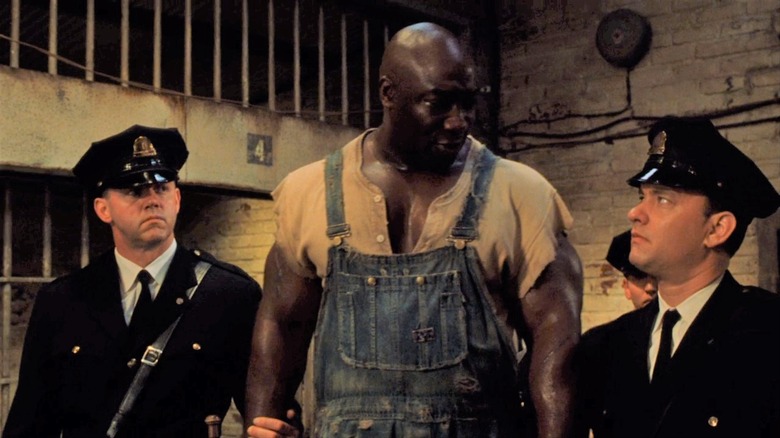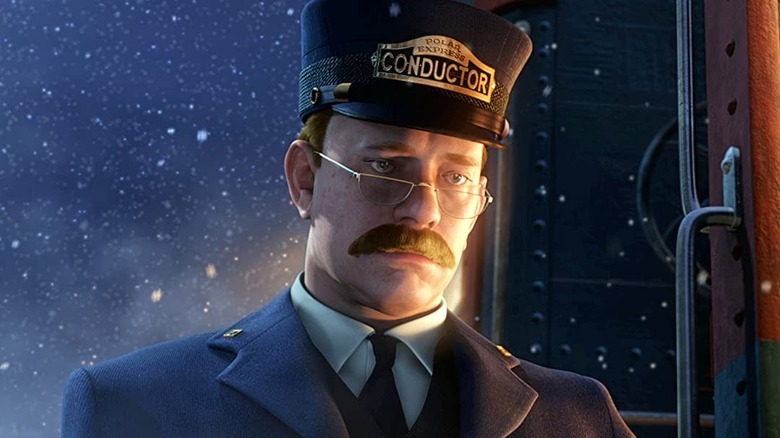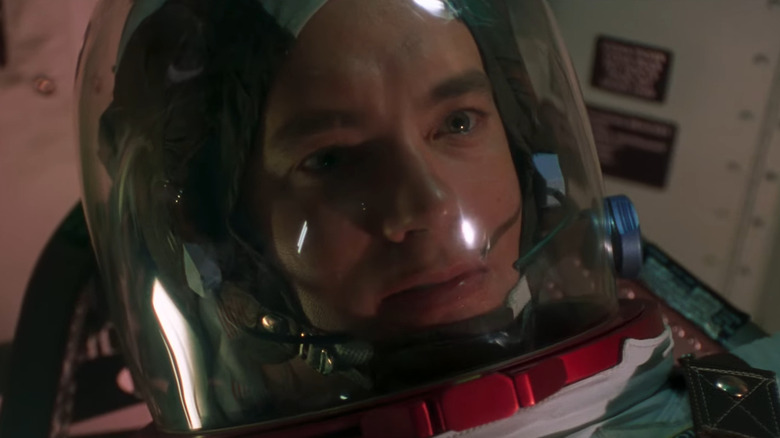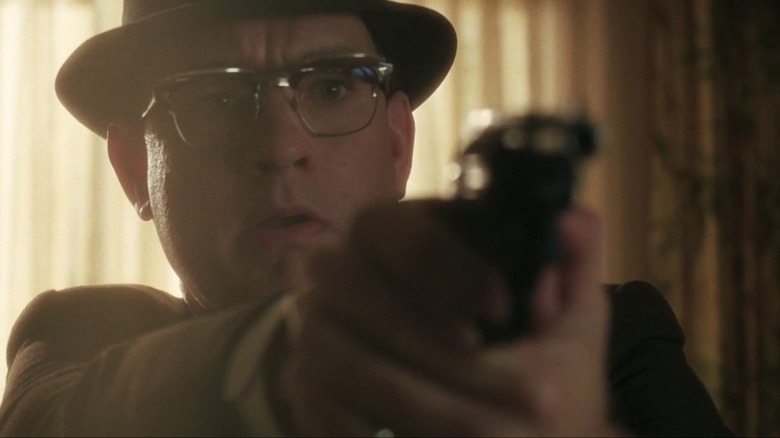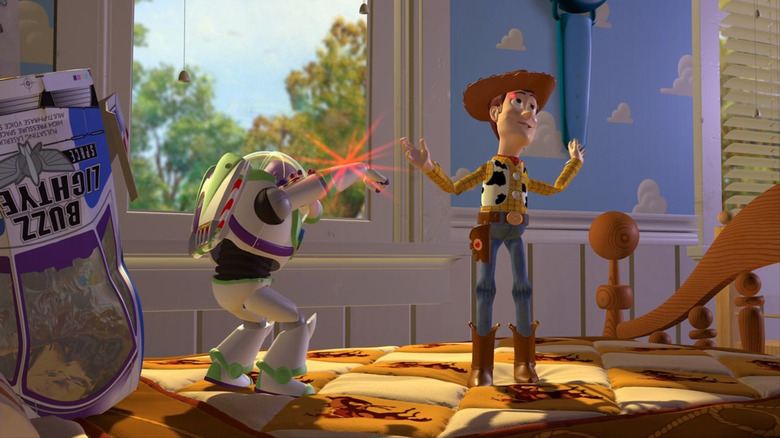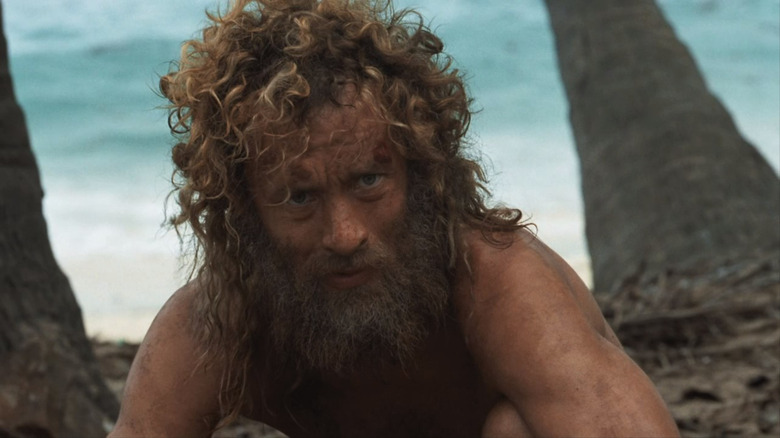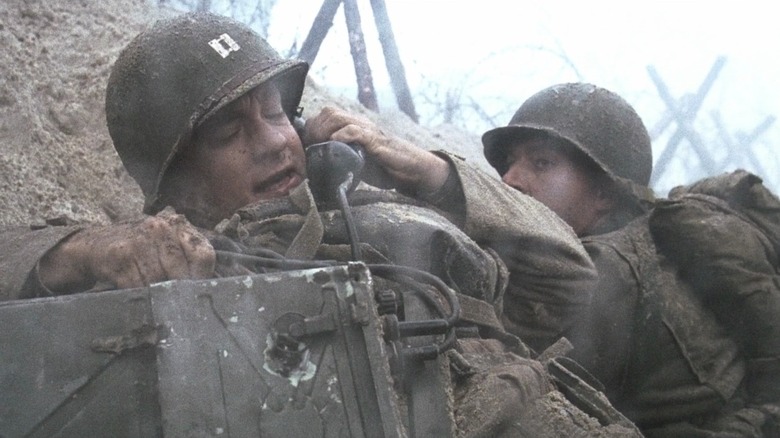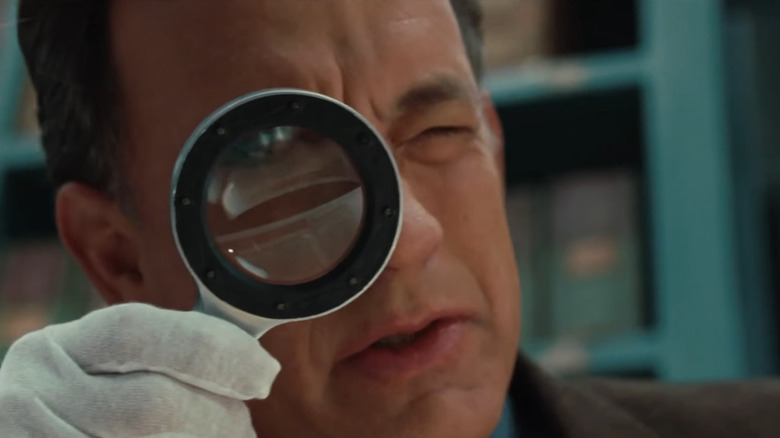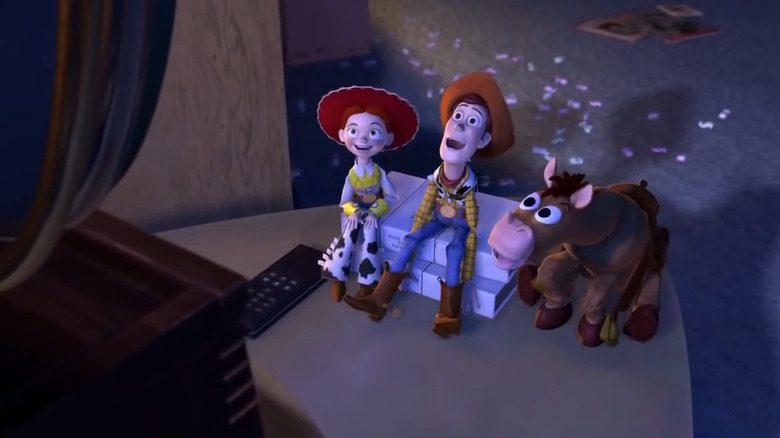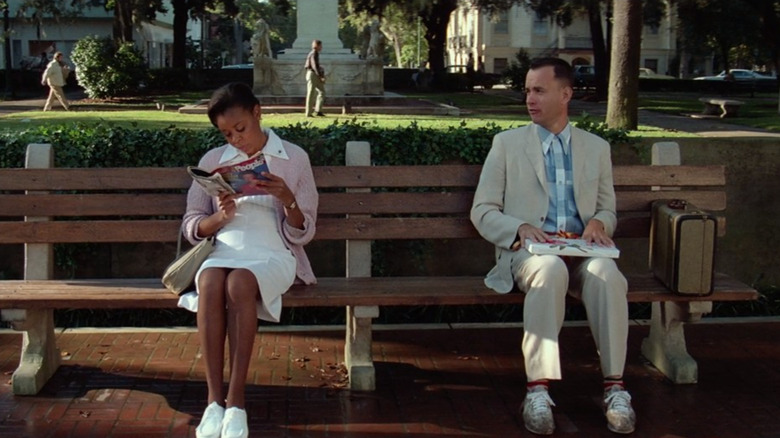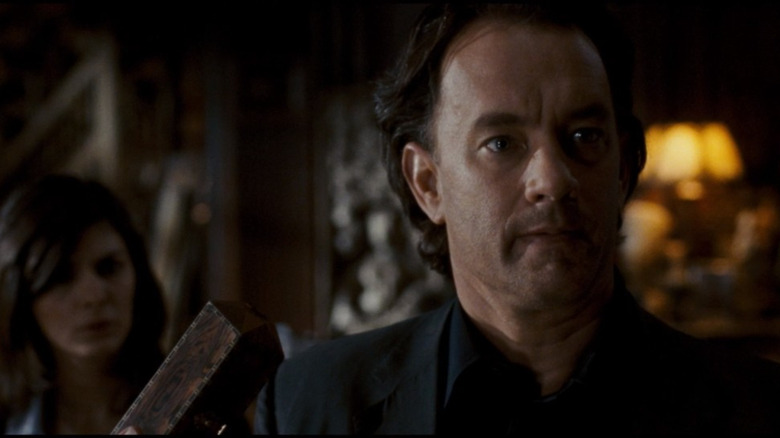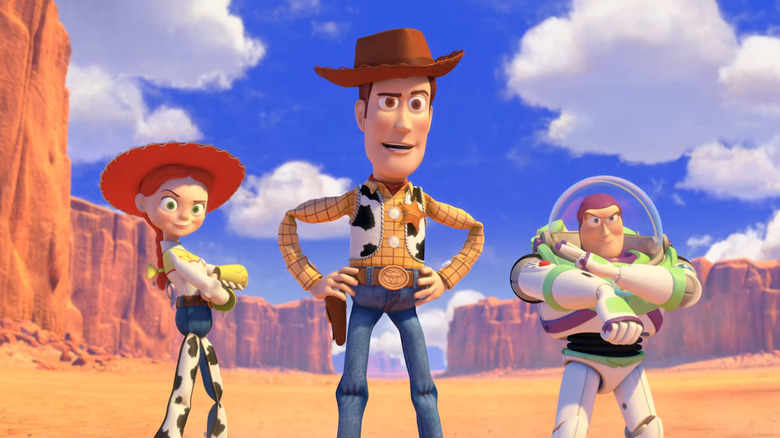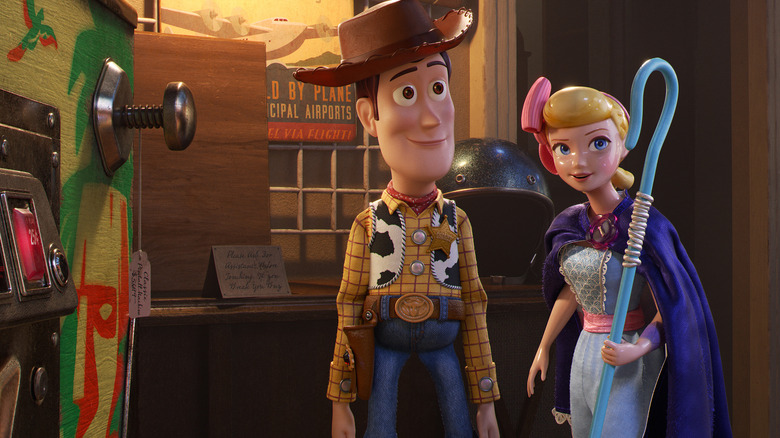Tom Hanks' Biggest Box Office Movies To Date
Tom Hanks didn't get the name America's Dad for no reason. Part of it is his innately warm persona, but it's also because he's been in so many popular movies that audiences love. How could moviegoers not take a shine to a guy whose appeared in everything from "Saving Private Ryan" to "Forrest Gump?" Appearing in a wide variety of titles and scoring some big Oscar wins along the way have made Hanks a reliable box office draw over multiple decades. Much like Sandra Bullock, Tom Cruise, or Denzel Washington, he's a big-name actor whose appeal has endured over multiple decades of moviegoing.
You don't get to that level of fame without appearing in a diverse array of films. The biggest movies at the worldwide box office that Tom Hanks has ever headlined are a varied bunch, some of them belonging to franchises, but others are one-off adult dramas, the kind of projects that theoretically shouldn't be able to gross $400+ million worldwide. Yet an actor as beloved as Hanks can pull off some extraordinary feats with his box office appeal. Like we said, they don't call him America's Dad for nothing.
14. You've Got Mail
Moviegoers circa. 1998 got an extra special Christmas present in the form of a reunion between Tom Hanks and Meg Ryan. The film "You've Got Mail" marked the third time the two actors worked together, with one of their two previous collaborations being the seminal 1993 romantic comedy "Sleepless in Seattle." Grossing $227.8 million worldwide, "Sleepless in Seattle" was such a massive success that it was inevitable that any future pairings of Hanks and Ryan would grab the public's attention. So it was that "Mail," which also brought back "Seattle" filmmaker Nora Ephron, became a solid moneymaker with a $250.8 million global haul.
Made for $65 million rather than the much cheaper $21 million price tag of "Seattle," "You've Got Mail" wasn't quite as profitable as the earlier Hanks/Ryan project. However, when a romantic comedy makes this much worldwide, debating profitability is tantamount to splitting hairs. The success of "You've Got Mail" is especially apparent when comparing it to other 1998 titles that it surpassed at the worldwide box office that year. Costlier 1998 movies, many of them with pre-existing brand names to lean on — like "The Mask of Zorro," "Lost in Space," and "The X-Files: Fight the Future" — all made less than "You've Got Mail" at the worldwide box office. Putting Hanks and Ryan back together, complete with an eye-catching premise and a wise Christmastime release date, ensured that "You've Got Mail" would build on the box office success of "Sleepless in Seattle."
13. The Green Mile
While the biggest Stephen King movie adaptations at the box office have often been horror films, like the "It" series, "The Green Mile" was an incredibly impressive success. Released in 1999, "The Green Mile" wouldn't be instantly recognizable as a Stephen King story, though it's another prison-set drama much like 1994's "The Shawshank Redemption." Helping to fuel "The Green Mile's" box office success even more than the name brand presence of King, though, was Tom Hanks occupying the film's lead role, fresh from his 1998 hit "Saving Private Ryan."
Released in December 1999, "The Green Mile" managed to gross $290.7 million worldwide, including $136.8 million in North America alone. Doing nearly five times its budget, "The Green Mile" benefited not only from the presence of Hanks but also from being an award season darling. Some high-profile Oscar nominations, including ones for best picture and best supporting actor, ensured that "The Green Mile" could keep on trucking at the global box office months after it first premiered. The fact that it could build on the cult following of "The Shawshank Redemption" certainly didn't hit either. Even if it wasn't quite a standard Stephen King movie adaptation, "The Green Mile" still went the distance at the box office, breaking hearts and jerking plenty of tears along the way.
12. The Polar Express
After the duo yielded a best picture win with the 1994 film "Forrest Gump," Tom Hanks and director Robert Zemeckis reunited for an adaptation of the 1985 children's book "The Polar Express." Here, Hanks would play not just one character but oodles of them, ranging from a hobo to Santa Claus to even providing the motion capture for the film's adolescent protagonist. Audiences would get a lot of Hanks for their buck on this feature, not to mention tons of Yuletide cheer and recognizable imagery from the original "Polar Express" book. That was all enough to bring in a sizeable box office haul, even if "The Polar Express" wasn't quite as profitable as to be expected thanks to its massive budget.
Grossing $312.7 million worldwide, "The Polar Express" was especially popular in North America, where it grossed $162.7 million in its initial run in the territory before amassing a sizeable $25.8 million in the years to come through theatrical re-issues. The problem here, though, was a $170 million budget, which has ensured that "The Polar Express" hasn't doubled its budget even after years of Christmas-themed re-releases. It also came up short globally compared to other, much cheaper movies starring Hanks, such as "Catch Me If You Can." Still, even if it wasn't an immediately profitable enterprise, "The Polar Express" did jangle up quite a few box office dollars around the world.
11. Apollo 13
Tom Hanks cemented himself as the premiere movie star of the 1990s through anchoring movies that were both box office hits and Oscar darlings. After headlining the immensely lucrative "Forrest Gump" in 1994, Hanks' "Apollo 13" would also prove appealing to both moviegoers and award season voters in 1995. Usually, you have to trade off box office clout for critical acclaim or vice versa, but Hanks was proving you could have it all. Granted, "Apollo 13" — the tale of a failed trip to the moon that turns into an incredible story of survival — may not have been as big as "Forrest Gump," but it was otherwise about as successful as you could expect an adult drama to be.
Amassing $335.8 million globally, "Apollo 13" was a remarkable success, even on a hefty (for 1995) budget of $65 million. Hanks, fresh off all that "Forrest Gump" success, was no doubt a pivotal part of getting many moviegoers into theaters to see "Apollo 13," but the true allure here was seeing a historic moment of American history rendered as a massive film. You don't need to explain to people in the marketing what the titular mission of "Apollo 13" means — everybody and their grandmother was well aware of it. That kind of built-in recognition is what informs sizeable box office hits, including ones that get nominated for scores of Oscars. It's not every day you see a box office performer like that, but then again, it's also rare for movie stars of Hanks' caliber to emerge.
10. Catch Me If You Can
Tom Hanks and Steven Spielberg united forces for the first time in 1998 with "Saving Private Ryan," but it would be far from their last time working together. The actor/filmmaking duo reunited for "Catch Me If You Can" in 2002, a project that was anchored by Leonardo DiCaprio playing a con man who pulls off such incredible schemes that, of course, the whole thing is based on a true story. The four-piece combo of Hanks, Spielberg, DiCaprio, and real-life adventures proved to be a potent allure for audiences.
Grossing $355.6 million worldwide, "Catch Me If You Can" was ridiculously profitable on a $52 million budget. Even better, it stood out compared to other Spielberg directorial efforts. Even with how many hits this filmmaker has helmed, "Catch Me If You Can" narrowly cracked the top 10 biggest Spielberg directorial efforts worldwide at the time of its release. Even more impressive, "Catch Me If You Can" wasn't a movie with lots of visual effects like "Jurassic Park" or even based on a massively influential historical figure like "Lincoln. It was an adult-skewing comedy/drama caper that got most of its appeal to moviegoers through its star power, as well as its positive word of mouth. Some movies can't get by with just those qualities, but then again, most movies aren't as charming and smooth as "Catch Me If You Can."
9. Toy Story
The world of big-screen animation will always be defined by a time before and after "Toy Story." The first feature-length computer-animated movie to ever grace theaters, "Toy Story" was making technological history, not to mention being the first collaboration between Disney and Pixar. Today, it's fairly obvious that "Toy Story" was destined for greatness given how so much of American cinema has been made in its shadow, but back in 1995, this was a brand new form of storytelling ... and audiences ate it up.
In its original theatrical release, "Toy Story" loudly heralded the arrival of computer animation as a force to be reckoned with thanks to it grossing $365.2 million worldwide. This put it ahead of the hand-drawn animated Disney film "Pocahontas" from the same year, while it came in behind only "Die Hard with a Vengeance" among all movies at the 1995 global box office. While it was far from the only element informing its enormous success, "Toy Story" did have the advantage of excellent timing in being one of the first Tom Hanks vehicles released after his Oscar-winning box office phenomenon "Forrest Gump." "Toy Story" continued this man's hot streak at the box office and signaled a new age for American animation.
8. Cast Away
Some of the biggest Tom Hanks movies have seen him rubbing shoulders with massive stars, like Meg Ryan or Leonardo DiCaprio. Pairing Hanks up with such famous faces has often resulted in sizeable box office returns, with this actor getting to reap the benefits of appealing to another star's fanbase. But with "Cast Away," Hanks only had himself and a volleyball to grab the attention of prospective ticket buyers. It was a risky gamble, even for a man who had been headlining successful films for almost two decades. Could Hanks, all by his lonesome, be enough to anchor a financially successful movie?
The answer turned out to be a resounding "yes" since "Cast Away" grossed just over $427 million at the worldwide box office. This included a whopping $233.6 million domestically, the second-biggest North American haul ever for a live-action film anchored by Hanks. It was also the third-biggest movie of 2000 globally, beating out the likes of "How the Grinch Stole Christmas" and "X-Men" for that honor. Even better, "Cast Away" cost only $85 million to make, meaning the film was wildly profitable for all involved. While Hanks has often benefited in his career from a solid co-star, "Cast Away" proved his financial ability to excel even with just a volleyball by his side.
7. Saving Private Ryan
Typically, movies released to theaters in late July are big blockbusters, like "The Lion King" or "Star Trek Beyond." Even back in the 1990s, conventional crowdpleasers like "Air Force One" or "George of the Jungle" were the de facto movies you'd expect to see on the big screen in the waning days of summertime. In other words, it's not when you'll typically find your big dramas. But in July 1998, "Saving Private Ryan" premiered well outside of the timeframe of awards season to unleash a grueling look at World War II on moviegoers. It was a bold release strategy that could've seen the title getting swallowed up by bigger blockbusters. However, as history has proven, "Saving Private Ryan" ended up excelling in this unique release strategy.
Grossing $485 million worldwide, "Saving Private Ryan" managed to secure $216.3 million in North America alone. It suck around for ages in this territory, buoyed by good word of mouth, with "Ryan" managing to stay in wide release for 15 consecutive weeks. Even better, it managed to set multiple box office records that would endure for ages. One of these included being the biggest war movie ever domestically, an achievement it would hold until "American Sniper" blew up in wide release in 2015. It was also the number one movie of 1998 domestically, the last time an R-rated title would top the yearly domestic box office for over a decade until "American Sniper" also swooped in and took that record away.
6. Angels & Demons
"The Da Vinci Code" was such a big hit in 2006 that it was only a matter of time before a sequel happened. However, there was always a question lingering over follow-up "Angels & Demons" on whether or not the financial magic of its predecessor could be replicated. "The Da Vinci Code" arrived into theaters on a tidal wave of buzzy controversy, and it would be hard to mimic that kind of pre-release hype with "Angels & Demons," especially since the Dan Brown book wasn't as popular as "Code." In the end, "Demons" didn't come close to match the first Robert Langdon movie in global box office, but it still proved to be a strong financial performer nonetheless.
In North America, "Angels & Demons" grossed $133.3 million, down 39% from "The Da Vinci's Code" haul in the same territory. However, just like its predecessor, "Angels & Demons" made way more internationally than it did domestically, with overseas territory giving this one a sizeable $357.5 million box office. That brought "Angels & Demons" to a $490.8 million worldwide gross, not too shabby for a movie costing $150 million to make. Even more impressive, "Angels & Demons" was the ninth-biggest worldwide grosser of 2009 and the second-biggest movie globally that year from Sony/Columbia. Even if it wasn't able to match the haul of "The Da Vinci Code," it'd be hard to complain about the box office intake of "Angels & Demons."
5. Toy Story 2
In retrospect, you'd think there'd be no doubt that "Toy Story 2" would be a massive hit given how beloved the original film was. Still, "Toy Story 2" had an enormously troubled production that saw it experience every tortured problem possible, from almost getting deleted to getting upgraded to a theatrical release at the last minute. Plus, big-screen animated sequels were nowhere near as common in 1999 as they are today. It was fair to wonder if moviegoers would shell out cash to see a follow-up in theaters rather than wait for home video.
The box office results for "Toy Story 2," which brought back Tom Hanks along with the rest of the first film's voice cast, promptly answered whether audiences had any interest in a sequel. Grossing $511.3 million worldwide, "Toy Story 2" was a global phenomenon that managed to leave its predecessor's global box office total in the dust. Even more impressively, it managed to be nearly as big on opening weekend as massive live-action blockbusters of the 1990s like "The Lost World: Jurassic Park." Rather than coming off as a rehash of the original "Toy Story," "Toy Story 2" registered as a welcome visit with old friends. With this feature, Hanks secured another animated hit on his resume, and the financial viability of animated sequels was solidified.
4. Forrest Gump
By 1994, Tom Hanks was a big deal as an actor, but he hadn't quite hit his apex in terms of box office clout. Up to this point, he'd only appeared in three movies that had cracked $100 million in North America, and none of them had exceeded $130 million in that territory. But that would all change with "Forrest Gump," which would hit extraordinary heights at the box office. Grossing $679.8 million worldwide, "Gump" wasn't just above all other Hanks movies up to that point, it was also heads and shoulders above the box office runs of most other movies.
That global haul included a massive $330.1 million in North America, which was enough to make it the second biggest movie at the 1994 domestic box office, beaten only by "The Lion King." The worldwide haul of "Forrest Gump" was also enough to put it ahead of all but one live-action movie Hanks has appeared in during his entire career thus far. "Forrest Gump" got a major boost in its box office run by being a pleasant nostalgia trip for older viewers through the 1950s, '60s, and '70s, while the combination of groundbreaking visual effects with heart-tugging sentimentality is a potent mixture that can never be underestimated.
3. The Da Vinci Code
In retrospect, the idea of "The Da Vinci Code" being something loaded with controversy seems more than a tad silly. In the context of history, "The Da Vinci Code" was just one of several 2000s movies aping old-school adventure and treasure hunting movies, like "National Treasure" or even "Indiana Jones and the Kingdom of the Crystal Skull." It has about as much hefty things to say about theology as "Crystal Skull" did about astronomy. But at the time of its release, "The Da Vinci Code" was drowning in controversy, with various Catholic and Christian institutions taking umbrage with how the plot concerned the idea that Jesus Christ impregnated a woman.
All the fury and controversy only heightened the attention on this project, which was already on the general public's radar given the popularity of its source material, Dan Brown's novel of the same name. The allure of seeing something popular and quasi-dangerous on the big screen, not to mention the presence of Tom Hanks as protagonist Robert Langdon, drove "The Da Vinci Code" to a massive $767.8 million worldwide gross. The #2 movie of 2006 at the global box office, "The Da Vinci Code" also managed to dethrone "Forrest Gump" as the biggest live-action movie Hanks has ever headlined. It can be difficult to understand or comprehend the controversy over "The Da Vinci Code" nowadays, but the gravity of its endless box office achievements will always be understandable.
2. Toy Story 3
There was a time when it was rare to see sequels on the Pixar slate. Before the 2010s delivered a deluge of follow-ups of varying degrees of quality, Pixar only produced one sequel among its first 10 movies, "Toy Story 2." As it entered a new decade with the 2010s, the studio delivered only its second sequel ever with "Toy Story 3." Arriving more than a decade after its predecessor, anticipation was super high for the project, especially since the now college-bound Andy mirrored the age of many viewers who'd first watched the original "Toy Story" titles as children.
The years of built-up anticipation and that ability to tap into real-world relevance, not to mention the might of the Disney marketing machine, ensured that "Toy Story 3" was always going to be a hit to some degree. However, even with so many factors working in this film's favor, the eventual $1.068 billion worldwide sum of "Toy Story 3" was still shocking. It was a massive achievement that not only ensured that "Toy Story 3" would be wildly profitable, it also cemented the film in the history books as the the very first animated film in history to exceed $1 billion globally.
1. Toy Story 4
With "Toy Story 4," the "Toy Story" saga wasn't just going to infinity and beyond. This series was also now going beyond the confines of a standard trilogy, a risky move for any franchise. Though positively received fourth movies — such as "Star Trek IV: The Voyage Home" and "Avengers: Endgame" — exist, many of them are more on par with the likes of "Shrek Forever After" or "Terminator Salvation." These installments tend to indicate a series is struggling to maintain its creative momentum and is straining to be as relevant as it once was. Leave it to the "Toy Story" saga, then, to subvert expectations and deliver a well-reviewed fourth entry that also managed to take the series to new heights at the box office.
With $1.073 billion worldwide, "Toy Story 4" narrowly eclipsed its predecessor's global cume, an impressive feat given that "Toy Story 3" arrived as much more of a long-awaited event rather than as just another "Toy Story" title. Among Pixar's films at the global box office, "Toy Story 4" surpassed every entry in the studio's canon except for "Incredibles 2." "Toy Story 4" also grossed enough to register as the sixth-biggest animated movie ever at the worldwide box office. Though it had been nearly 25 years at this point, the animated saga Tom Hanks first appeared in back in 1995 was still going strong in 2019.
